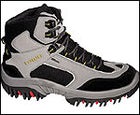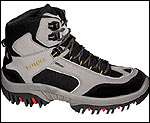A lot depends on snow conditions, terrain, temperature, how long you intend to be out, and so on. But, the main notion is that you are going outdoors, in cold weather, and always run the risk of getting stuck for a while. So I’d opt for heavier and warmer rather than lighter and less warm.
 Whistler GTX
Whistler GTX
For that reason, I tend to prefer light plastic mountaineering boots. They’re warm, keep your feet dry, and offer plenty of support for negotiating steep terrain. Of course, the downside is that they’re rather pricey—$269 for a boot such as the Koflach Degre (www.koflach.com), and that may be a little hard to swallow. Good-quality leather hiking/climbing boots can also work, and one good example of that would be the La Sportiva Glacier, which sells for $225 (www.sportiva.com). Almost any boot you have in hand now can also be adapted to snowshoeing. Don some wool socks under your Gore-Tex socks, maybe add a full overboot such as Outdoor Research’s X-Gaiters ($106, www.orgear.com), and you can readily winterize footwear.
Alternatively, in recent years several boot makers have introduced a line of “snow-sport” boots, which are light hikers tuned for winter use with insulation and additional waterproofing. They don’t offer a ton of support for use on steep terrain, but they’re comfortable, pretty warm, and not that expensive. The Lowa Whistler ($125, www.lowaboots.com) and Merrell Blizzard ($110, www.merrell.com) both are good examples of this genre. For light snowshoeing on moderate terrain, I’d say they’re fine.


